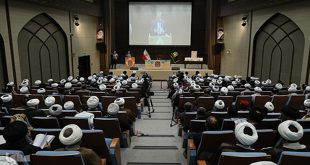The concept of protecting the Citadel of Islam (Hifẓ Bayzat al-Islam), is common in the lexicon of Shiʿi political jurisprudence.
It refers to those Islamic principles and foundations without which the existence of Islam and the Muslim community would be in danger. During the Occultation Era, Shiʿi mujtahids, as general deputies of the Hidden Imam, are believed to commit their utmost effort to fulfilling this sacrosanct responsibility. The meaning and applications of the concept have been evolved throughout the Shiʿi history. A noteworthy case of protecting the citadel of Islam is the position of Sayyid Abu’l-Ḥasan al-Iṣfahānī (1867-1946) and Mirza Muhammad-Ḥusayn Nāʾīnī (1862-1937), vis-à-vis the Najaf seminary and the newly established Hashemite dynasty in early twentieth century. This paper aims to shed more light on the concept of the Citadel of Islam, its implications in Shiʿi political thought, and contemporary applications.
In one of his speeches given in 1980, Ayatollah Khomeini addressed a group of seminary scholars, exhorting them that as ulama they were preservers of Islam and protectors of the Citadel of Islam (Bayzat al-Islam). ‘Citadel of Islam’ is a multivalent term of Shiʿi political jurisprudence that encompasses the meanings ‘genesis’, ‘entity’, and ‘core community of Islam’. It appears in an exceptional principle known as wujūb hifẓ Bayzat al-Islam that has shaped the jurisprudential reasoning (ijtihād) of qualified Shiʿi jurists (mujtahids) throughout history and encouraged them either to become politically active and/or to remain quiet, as circumstances demand: the obligation to protect the Citadel of Islam. As this paper elaborates, mainstream Shiʿi doctrine prescribes that any socio-political aim must be secondary to this unshakeable principle.
In contrast to their Sunni counterparts, at least until recent decades mainstream Shiʿi mujtahids have been independent of the state. They relied largely on their individual and organisational capabilities to mobilise the public and claim an exclusive right over their lay followers. The principle of guardianship (wilāya), arguably embedded in the Shiʿi mujtahids’ identity, is rooted in the charisma of the twelve infallible Imams, their so-called general dep-uties, the mujtahids, and the loyalty and devotion of their followers. The political postures of the Imams and Shiʿi mujtahids have stemmed from their ability to consolidate a popular constituency. This is how the pro-ijtihād Uṣūlī scholars read the political history of Shiʿi Imams and their followers. In their words, whenever the infallible Imams perceived support from the community, they became actively engaged in politics; otherwise, they remained quiet. Consequently, as the general deputies of the Imams during the Occultation Era, the Shiʿi mujtahids have appropriated some of their prerogatives, claimed for themselves similar responsibilities and political postures. For mujtahids, all the deeds of the infallible Imams during their lives from the death of the Prophet Muhammad, 632 CE, to the commencement of the Occultation of the twelfth Imam, 873 CE, could be seen to be actions of a ‘Perfect Man’. In their classical view, Shiʿi mujtahids opine that the quietism of ʿAlī b. Abī Ṭālib, the first Imam, over the question of the Prophet’s succession and the caliphate of Abū Bakr was partly due to the fact that ʿAlī failed to gain the support of the Muslim majority at the time. He remained quiet and abstained from public affairs for the next two decades. It was only when scores of Muslims gathered outside his house and asked him to accept the caliphate that he agreed to become politically active once again. ʿAlī justified this move from quietism to activism thus…..
Bibliographic Information
Title: Protecting the Citadel of Islam in the Modern Era: A Case of Shiʿi Mujtahids and the Najaf Seminary in Early Twentieth-Century Iraq
Author(s): Mohammad R. Kalantari
Published in: The Muslim World, Volume 110, Spring 2020
Language: English
Length: 15 page
 Ijtihad Network Being Wise and Faithful Muslim in the Contemporary World
Ijtihad Network Being Wise and Faithful Muslim in the Contemporary World

